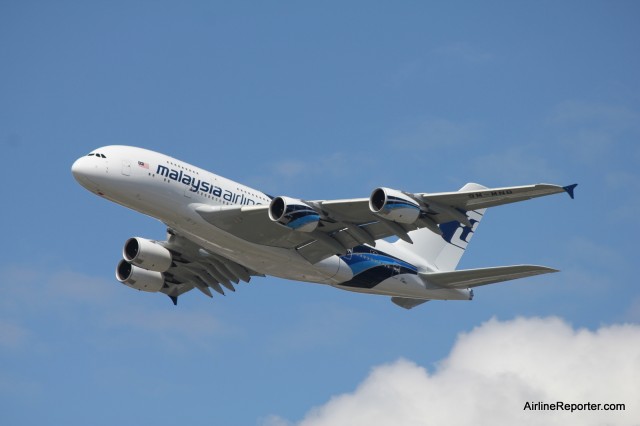
Malaysia Airlines Airbus A380 flying over the Farnborough Airshow.
Malaysia Airlines recently took delivery of their first Airbus A380 and brought its second to the Farnborough Airshow to show it off.
Invited guests were allowed to take a tour of the interior and everyone with-in sight of the airport was able to see the A380 perform in the sky.
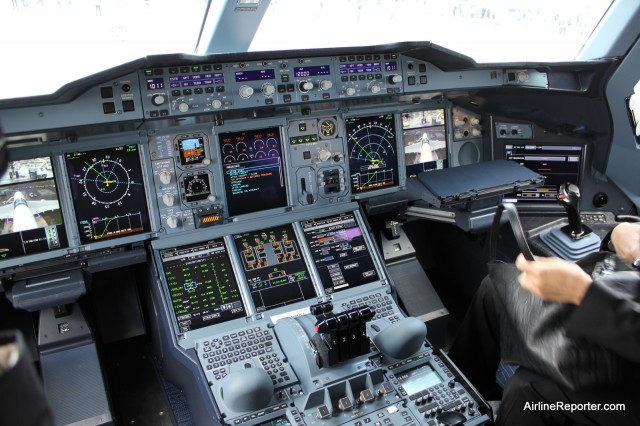
Like other A380’s, the cockpit is huge.
If the livery doesn’t look familiar to you, that is because the airline decided to give all their A380’s a special livery. The livery was a surprise (or a last minute decision), since the aircraft first flew with the standard livery on the tail. When seeing the design in photos, I wasn’t so sure what to think about it, but it really pops in person.
The main problem is the outside color scheme doesn’t match the inside. While the outside uses different shades of blue, the interior uses reds, which is a bit of a mind boggle when first boarding, but I am sure most people won’t even notice.
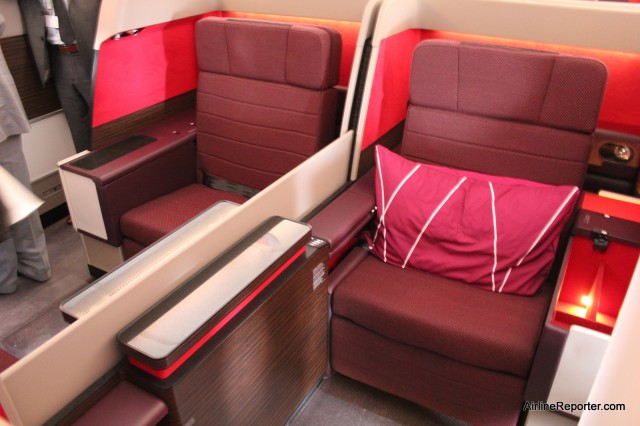
First Class is found on the lower deck.
The airline decided to put their eight First Class seats, which are laid out in a 1-2-1 formation, on the main deck, at the front. First Class are mini-suites that contain a lay-flat bed, 89″ pitch, 23″ screen, power at the seat and a personal closet. To create a sense of height (literally), there are not overhead bins in First Class.
I have to say that the product seemed quite impressive, but I was not a fan of the materials and colors. A bit too much red and brown for my taste, but it could be cultural. I think I could probably get over the coloring and enjoy the product.
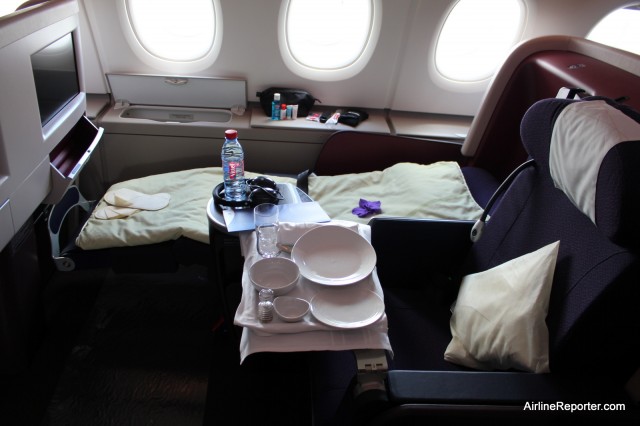
A Business Class seats in sleeping and eating positions.
Business Class is found on the front part of the upper deck and is in a 2-2-2 configuration. The 66 full flat seats have a 74″ pitch, a 17″ screen and a power supply.
This Business Class is a pretty standard product out in the industry today — which is not a bad thing. There seemed to be plenty of storage (especially those seats up stairs with the side-bins) and the color I liked.
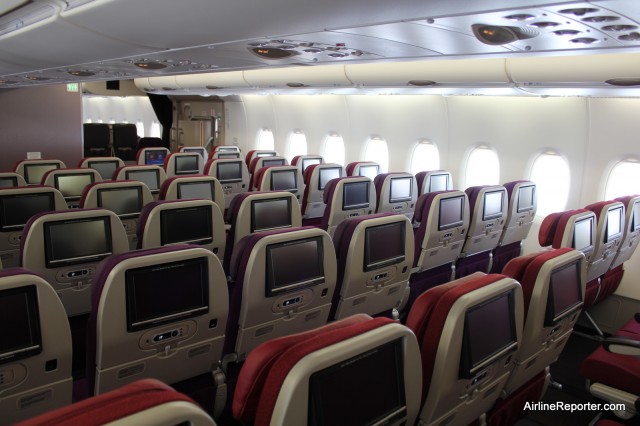
Each Economy seat has a pretty large screen and a iTouch remote.
Economy is set up in a 2-4-2 on the upper deck and 3-4-3 on the main deck. They offer 32″ of pitch, seat power, and a 10.6″ screen.
If you are going to be flying in economy, trying getting a seat on the upper deck. Not only do you get to feel special for being on the upper deck, but if you score a window seat, you will be rewarded with extra arm room and a cubby between your seat and the wall.
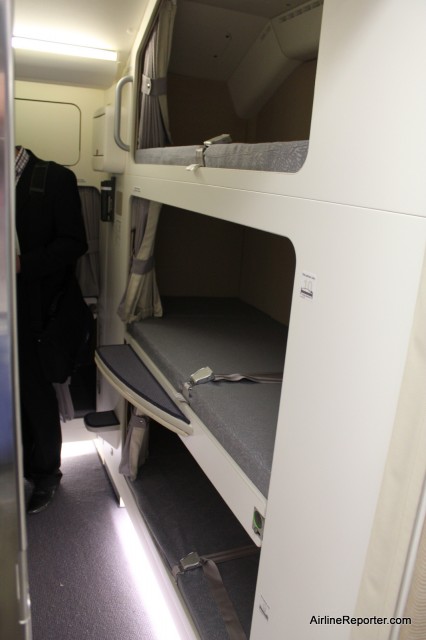
Flight crew have 12 bunks, three high, located at the rear of the upper deck.
One thing you will not find in the First Class cabin or the entire upper deck are baby bassinets. That is because Malaysia Airlines will only allow babies to fly in the economy section on the main deck.
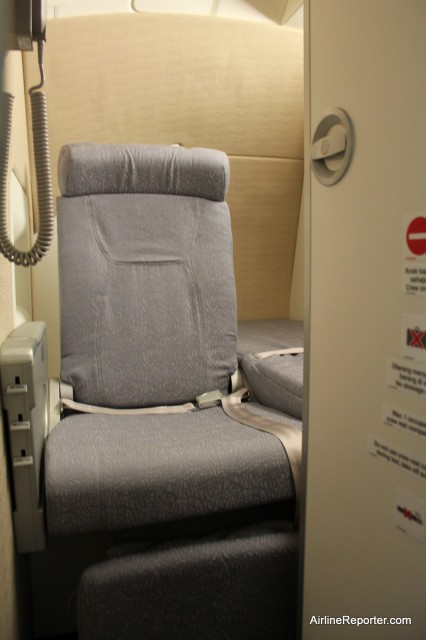
Pilot rest area behind the cockpit.
Behind the cockpit, there are three small rooms. Two are rest areas for the pilots and one is their private lavatory. The cockpit is located between the A380’s two decks, so it takes a few steps to get in.
The actual cockpit itself is huge. We had about six people in it with no problem what-so-ever. You could really throw a party up there, but it is probably best to just stick with flying.
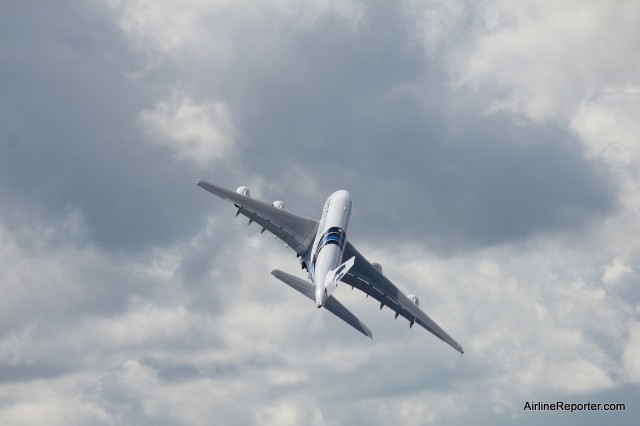
The Airbus A380 shows its moves at the airshow.
It was all well and fun checking out the inside of the A380, but the real impressive part was seeing this beast in the air, doing aggressive maneuvers during Farnborough. I am sure A380 pilots do not get to experience flying the world’s largest airliners like that very often. What a great treat for them and for those of us on the ground.
ADDITIONAL MALAYSIA AIRLINES AIRBUS A380 PHOTOS (even more on Flickr):
[nggallery id=12]
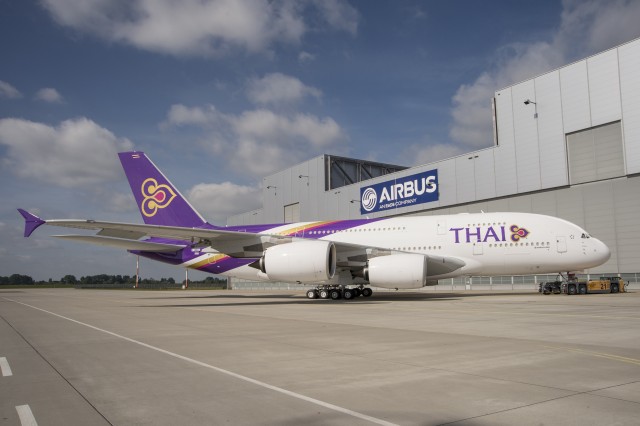
The first Thai Airways International (THAI) A380 rolled out of the Airbus paint shop during June 2012, marking completion of its painting and cabin installation work. Hi-Res Photo — Click for larger. Photo by Airbus.
Yesterday, Airbus showed off photos of Thai Airways International’s (THAI) first A380 that is in full livery.
The airline’s first double-decker has also completed interior installation and will now go through its final phase of ground and flight tests in Hamburg, before the aircraft will be believered to THAI sometime during the third quarter of 2012.
THAI will become the ninth operator of the A380 and the airline has firm orders for six A380s.
TAKE A PHOTO INTERIOR TOUR OF THAI’S A380 via Australian Business Traveler
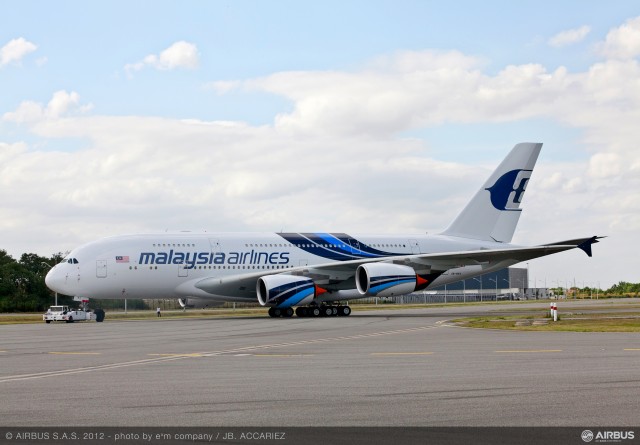
The first A380 for Malaysia Airlines (MAS) was unveiled today bearing its special celebration livery, ahead of entry-into-service next week on the Kuala Lumpur-London route. Hi-Res image — click for larger. Image from Airbus.
Airbus also showed off Malaysia Airlines (MAS) first A380, sporting a special “celebration livery.” The A380’s new paint scheme was added post-delivery and highlights the A380 as the flagship for the airline. The plane will start operations on the MAS Kuala Lumpur-London route next week and is configured in three classes with a total of 494 seats.
[nggallery id=7]
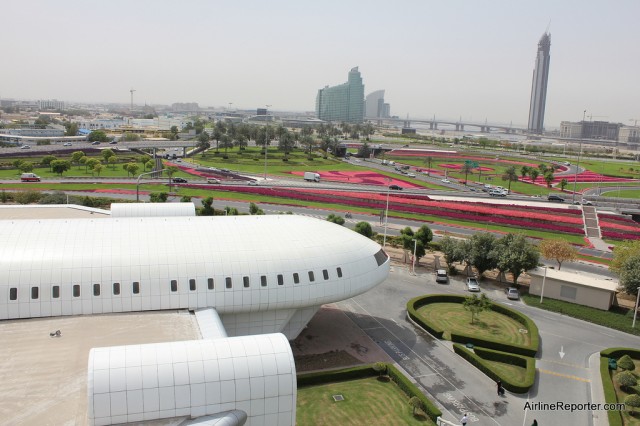
Yes. The building is designed to look like an airliner. Only in Dubai.
It was surreal pulling up to the Emirates Airline training facility in Dubai to find that part of the building was designed to look like an airliner — engines and all. In retrospect, it shouldn’t be too surprising, since this is the land of bigger and better and Emirates Airline seems to fit right in.
Emirates currently has a fleet of over 175 aircraft, flying to 120 destinations and they have no plans to slow down their growth. The airline hopes to hire around 4,000 additional cabin crew by the end of 2012.
Emirates is not an airline that cares only about the number of employees, but also the quality. They hire people from around the world to train to be some of the best flight crew in the world and Emirates Aviation College in Dubai is where every new hire will start.
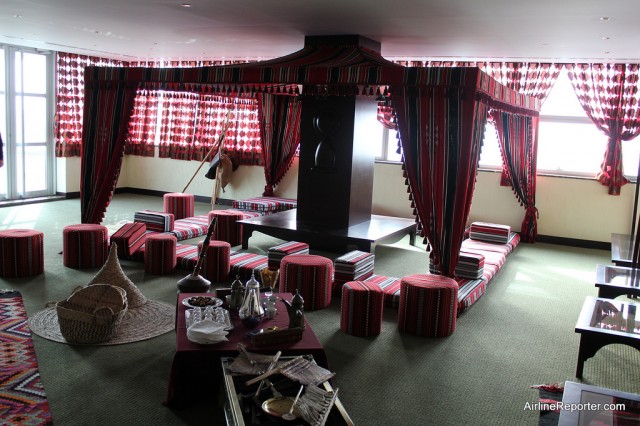
A Majlis, where students learn about the Emirates culture and the cultures of others.
Each week, about 80-120 near new trainees will start their seven week long educational journey. Each class is comprised of people from around the world, making Emirate’s employees some of the most diverse. At any given time, there are about 130 nationalities represented among the trainees and about 70 among the the trainers.
One of the first steps of every trainee is learning about Arabic hospitality and about the other cultures represented among the company and passengers in a themed roomed call the Majlis room. The crew’s diversity helps them easily interact with many of the passengers that will be flying on the airline.
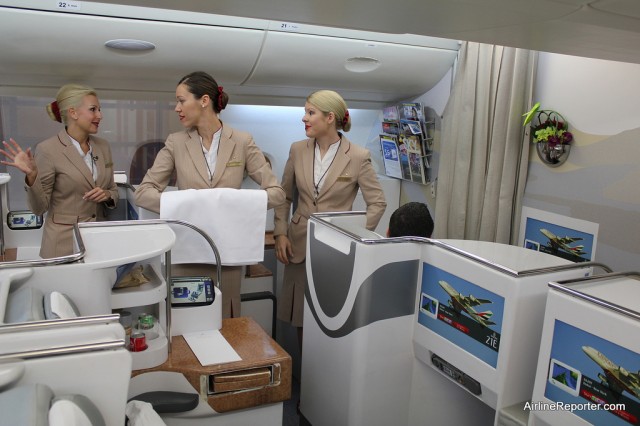
Flight Stewardesses train how to properly serve passengers in this Airbus A380 mock interior trainer.
One can only learn so much by reading out of a book or being lectured to. That is why each trainee is given hands on experience in one of the interior cabin mock-ups. From greeting passengers to learning what order to serve them food, to pointing out how to operate the on-board showers, the mock ups provide opportunities for students to learn new ways of doing things and to learn from their mistakes.
Each trainee is taught how each cabin is designed to give their passengers a unique experience. Emirates tries to make first class passengers feel like they are on a private jet, where business class passengers will receive a “my retreat” experience and finally a “surprising treat” type encounter for economy.
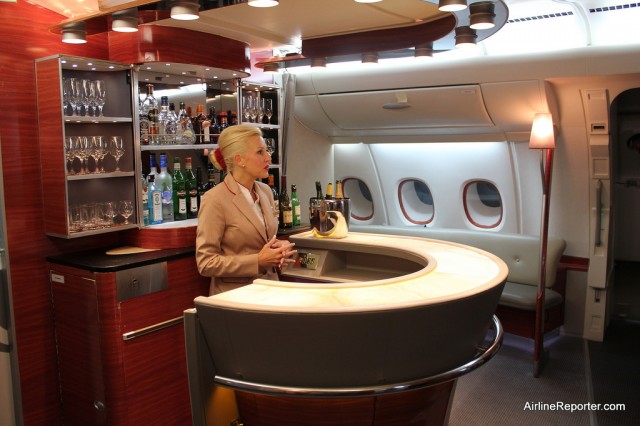
Part-time Emirates Trainer and Senior Flight Stewardess Lisa Williamson works the bar in the Airbus A380 trainer.
One part of the training is learning when it might be best to start weaning a passenger off alcohol, when they have had one too many. This can be more of a challenge when that passenger is in a public space, like the business and first class bar on board an Emirates Airbus A380. Unlike a bar on the ground, a drunk person cannot be kicked out. It takes a certain skill level to cut a person’s alcohol without insulting them. Lisa Williamson, part-time Emirates Trainer and Senior Flight Stewardess, explained how Emirates follows a delay, distract, dilute and then, deny strategy.
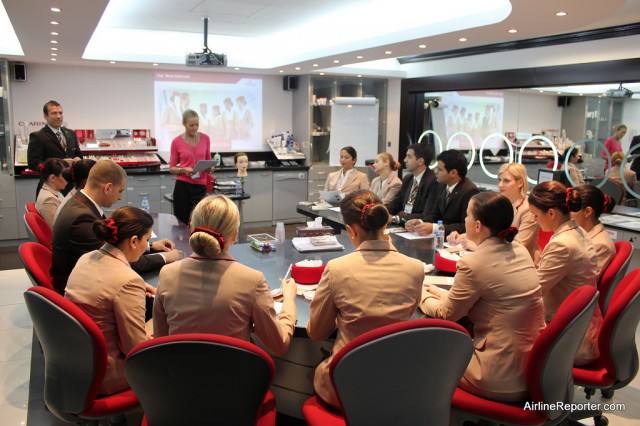
Every flight stewardess learns how to properly wear their uniform and wear make-up.
A group of Emirates flight crew walking in an airport garners attention — and for good reason. Their outfit is one that stands out and each trainee must go through training on how to wear their uniform, style their hair, apply their make up and of course on how to properly wear their signature red hat.
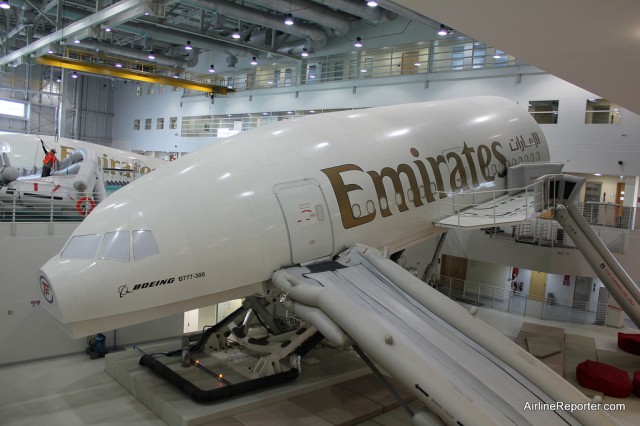
Emirates Boeing 777 safety trainer is able to move on three axis, providing realistic scenarios inside the cabin.
Although learning how flight crew should properly wear make up is interesting enough, getting to the training pool with a mock up for the Boeing 777, Airbus A380 and A330/A340 is much more aligned with my interests.
Unlike other safety training mock-ups I have seen, both the 777 and A340/A330 trainers are able to move on 3-axis. Due to the size of the larger A380 trainer, it did not move and was stationary.
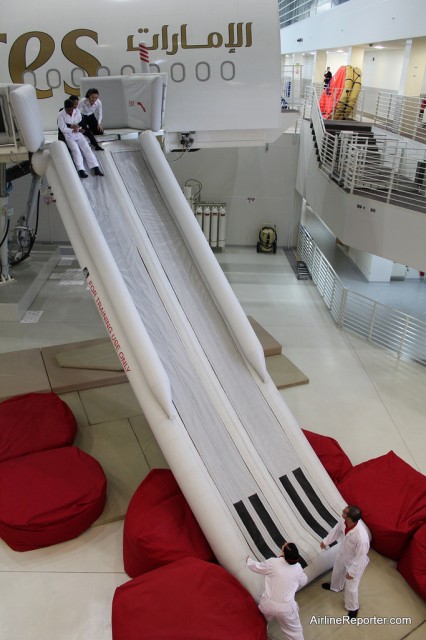
New trainees practice helping a passenger who is passed out down the slide.
In the aircraft training room there is a pool that is surrounded by all three aircraft mock-ups. On one side, crew are able to practice water evacuations, where on the the other side, slides allow trainees the ability to practice sliding to the ground. This can be a mentally and physically challenging part of training and those flight crew that are not able (or un-willing) to go down the slide, are unable to continue the overall training program.
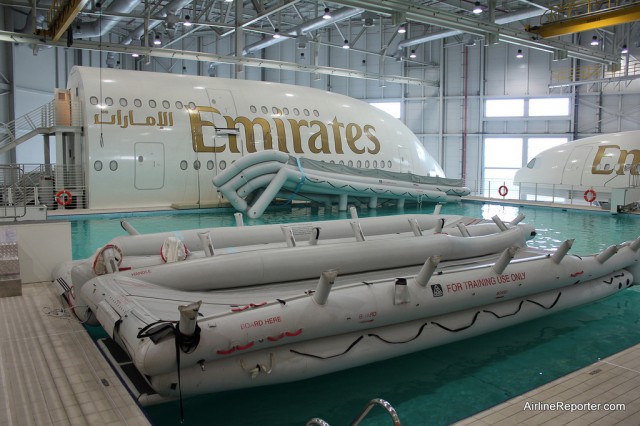
Emirates Airbus A380 and A340/A330 Safety Trainer.
Like most other things in Dubai, the aircraft training room was huge — it has to be. There was no shortage of eye candy watching both the A330/340 and Boeing 777 trainers rocking and rolling, hearing trainees yell for their training and seeing them jump out of the slides. I probably could have stayed in that room all day — heck probably all week.
Unfortunately during out visit, there was no one who jumped into the pool.
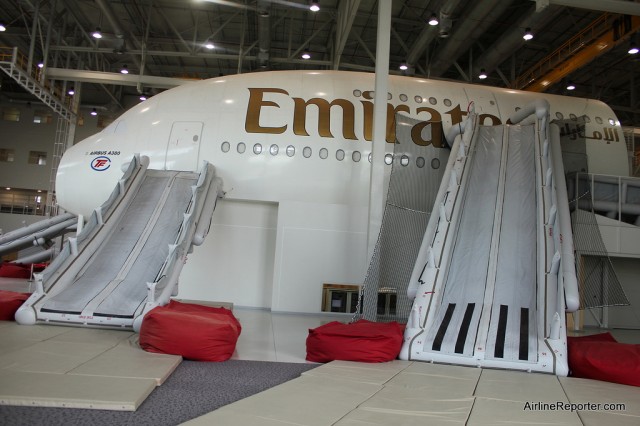
Who needs Disney Land, when you can take a ride on an Airbus A380 upper-deck slide.
The photo above does not accurately convey how steep and long the upper deck slide on the Airbus A380 is from the top to the ground. It made me feel a bit nervous just standing on the ground and I could imagine that some trainees would have some hesitation sliding down for the first time. At first glance, the facility might seem like fun and games, but crews are practicing worse case scenarios on how to keep passengers safe and how to save lives.
From providing the best customer service as possible, to helping passengers in a disastrous situation, the Emirates Airline Crew Training facility prepares everyone to have a successful career with the airline.
SEE ALL 35 PHOTOS OF EMIRATES TRAINING FACILITY
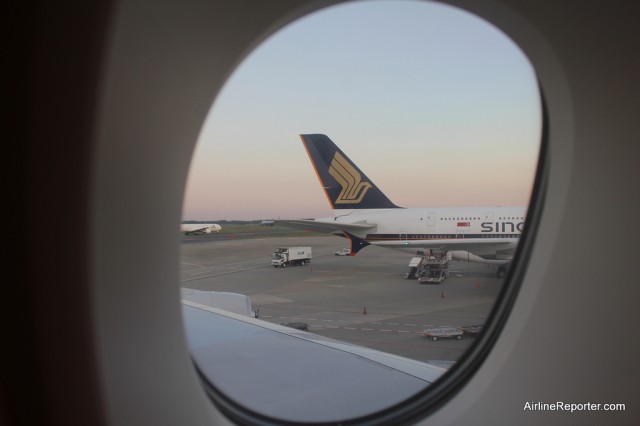
No Airbus A380 wings are going anywhere -- simmer on down folks.
“If it bleeds it leads” — a nice classic saying of writing sensational stories to get more traffic.
When I first heard of small cracks being found on Qantas and Singapore Airlines A380s I read up on it and found it to be a non-issue and not really worthy of writing a story. The majority of media covered it the way that they should — that cracks were found and they are no big deal. Some examples:
Toronto Star by Lesley Ciarula Taylor:
‘Non-critical’ cracks inside wings of Airbus A380 spark grounding call
ATWOnline by Geoffrey Thomas:
Minor cracks found in Qantas A380 wings pose no safety threat
Reuters by Harry Suhartono and Narayanan Somasundaram:
Singapore Air, Qantas say cracks found in Airbus A380 wings
USA Today by Ben Mutzabaugh:
Cracks found on A380 wing parts called ‘non-critical’
Then I start seeing more and more sensational headlines that were very misleading and it started to frustrate me. They acted like planes were going to start falling out of the sky and everyone needs to panic. Some of those examples:
Daily Mail by Rob Waugh:
World’s biggest super-jumbos must be GROUNDED, say engineers after cracks are found in the wings of three Airbus A380s
– Wow, even capitalizing the word “grounded” — classy.
CNET by Edward Moyer:
World’s largest passenger plane may be unsafe, some say
– I love the “some say,” it doesn’t really matter who, just some people are saying it and we are reporting it.
Gizmodo by Jamie Condliffe:
Airbus Refuses To Ground A380s Despite Cracks In Their Wings
– Or, they might refuse to ground them, because they do not need to be grounded.
BBC News by Tim Allman:
Airbus A380 fleet should be grounded, say engineers
– Well if engineers are saying it, then it has to be true.
What interests me is that those “some say,” and “engineers” all turn out to be the same one person in all these stories…
“We can’t continue to gamble with people’s lives and hope they make it until their four-year inspection,’ said Steve Purvinas, federal secretary for the Australian Licensed Aircraft Engineers Association.
What almost all the news sources do not say is that Purvinas’ organization has been fighting against Qantas’ decision to outsource maintenance jobs. Interesting huh? It would seem to me that this guy and the ALAEA might have an agenda.
Safeskies (an organization specializes in airline safety) chairman David Forsyth stated that, “I doubt the ALAEA union which made the comments, is technically trained or qualified to argue against Airbus structural design engineers about cracks in their aircraft. Airbus will investigate these cracks and promulgate an inspection program, agreed by the safety Regulators.” He continued with, “Using safety as a weapon in IR disputes, without reasonable grounds, is like the boy who cried wolf. Repeated ad nauseam, the impact will lessen over time, and if eventually there is a valid safety issue, it might be dismissed as just another rant.”
Airbus has confirmed the cracks, but stated that they are not a safety issue. “We have traced the origin to a material-related manufacturing issue and developed an inspection and repair procedure which will be done during routine, scheduled, maintenance checks. This is not a safety issue. Aircraft performance is not affected. Any fix, if necessary, can be done during regular (4 year) maintenance.”
Every single airliner ever build has had issues that do not affect safety. Aircraft manufactures issue thousands of service bulletins and the huge majority of them are very minor.
This really is a non-story that should have never received much coverage outside airline trade journals. Yet, it was too tempting for some journalists and their editors to write that an engineer stated that the fleet of A380s should be grounded. The airline business is a disproportionately mis-represented business already and stories like this do not help the situation.
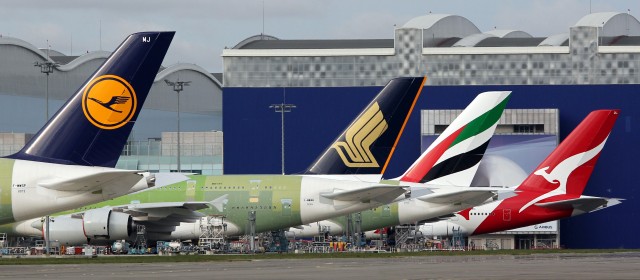
Lufthansa, Singapore Air, Emirates and Qantas Airbus A380s sit in Toulouse. CLICK FOR LARGER.
Photo was taken by A380_TLS, who also has a lot of other great photos from Airbus in Toulouse. Hat tip to Jon Ostrower for pointing this out.




















